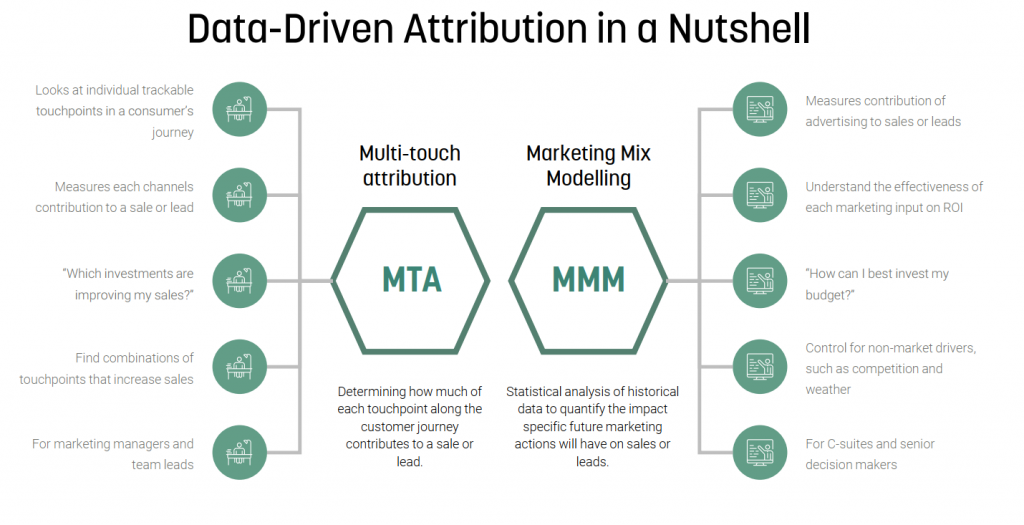Data-driven attribution: what you need to know?
Have you ever wondered how you can analyse your channels to know exactly where to invest more? Or maybe you wanted to understand which ads make potential customers move to the next step of the funnel? You probably already heard, but the solution is hidden in attribution — how the value of a conversion is distributed across channels that move the user through the funnel.

Last year, Google stirred the pot by releasing changes to default attribution models across accounts. The default attribution model for all new conversion actions in Google Ads will replace last-click attribution with data-driven attribution (DDA). In addition, it is removing any previously required data minimums for DDA attribution modeling and making it available for more conversion types, including in-app and offline conversions.
So buckle up, and let’s find out more about the data-driven attribution model.
A brief refresher on attribution models
No need to worry because we’ll take everything step-by-step. You probably want to have an overview of the existing attribution models and luckily for you, we got you covered.
1. Multi-touch attribution modelling evaluates the impact that each touchpoint has in driving a conversion, thereby determining the value of that specific touchpoint and it has various subtypes:
- Last-click: credits a conversion to the final ad and corresponding keyword a user clicked on when they finally converted.
- First-click: credits a conversion to the very first ad (and corresponding keyword) a user sees.
- Linear: credits a conversion evenly across all interactions involved with a customer’s path.
- Time-decay: credits a conversion to ad interactions that happened closer in time to the actual conversion.
- Position based: credits 40% of a conversion to each the first and last click, and 20% to the rest of the interactions.
- Data-driven: credits each conversion differently, because it looks at tons of different data signals that make up each conversion action
2. Marketing Mix Modeling is a technique that helps you understand how much each marketing input contributes to sales, and how much to spend on each marketing input. It’s also used to optimize the spending budget over these different marketing inputs.

What is data-driven attribution?
Data-ariven attribution (DDA) focuses on your advertising account’s data as a unique starting point for analysis.
Unlike other attribution models, Data-Driven Attribution doesn’t use a pre-defined model to assign credits to each touch-point. Instead, it uses machine learning technology to create a custom model for each business based on data that reflects the actual customers’ journeys.
Traditional rule-based attribution only evaluates paths that lead to conversions. In contrast, data-driven models consider both the converting and non-converting paths. This way, you can assess how each touchpoint increases the likelihood of a customer converting rather than merely allocating credits to the conversion path touchpoints based upon predefined rules.
How does all that help you? Data-driven processes provide a more comprehensive and accurate attribution evaluation, but we’ll tell you more about the benefits later on.
How does data-driven attribution compare to last-click attribution?
Since the last-click attribution is on its way out and we are welcoming the Data-Driven Attribution, it might be useful to understand two of the main differences between these two.
Firstly, DDA can give you a broader view of your conversion paths. In contrast, last-click attribution can be more rigid, only allowing the ad that brought in the final click to wear the conversion crown.
Secondly, last-click attribution only reports on complete conversions and DDA will credit interactions on ad towards a conversion action even if those interactions didn’t directly result in a completed conversion. In other words, DDA looks at various historical data points to know when an interaction is actually meaningful, while last click reporting is more limited.
What are the main benefits?
As promised, we made a short list of the most important benefits provided by a quality data attribution model:
- Improved budgeting: you’ll be able to understand how each channel contributes to your objectives and optimize your spending for various campaigns with high accuracy.
- Cross-channel impact analysis: lift and funnel stage reports will reveal how different channels and marketing actions affect one another.
- Unified view: data-attribution model will help you set up a unique set of metrics for every channel, aligned to your business goals.
- Reporting flexibility: generated reports can be viewed in multiple ways, allowing different teams to access the insights they need instantly.
- Performance over time: get ready to estimate and predict customers’ lifetime value, drop-off chances, and multiple other factors that impact your business’s bottom line.
Final thoughts
If we are talking about the future of attribution modelling, we are also talking about the analytics tools that are purpose-built to clarify the attribution process and provide a clear picture of where conversions come from. The more brands can harness the power of their own data from their channels, the more accurate their attribution models can become.
Data-driven attribution is the future. It is a valuable tool and can provide greater insights into how each channel and marketing campaign impacts the customer buyer journey. By using the model, you’ll see results grow stronger as time passes, especially as you continue to refine your strategies.
Considering sharing with others


)